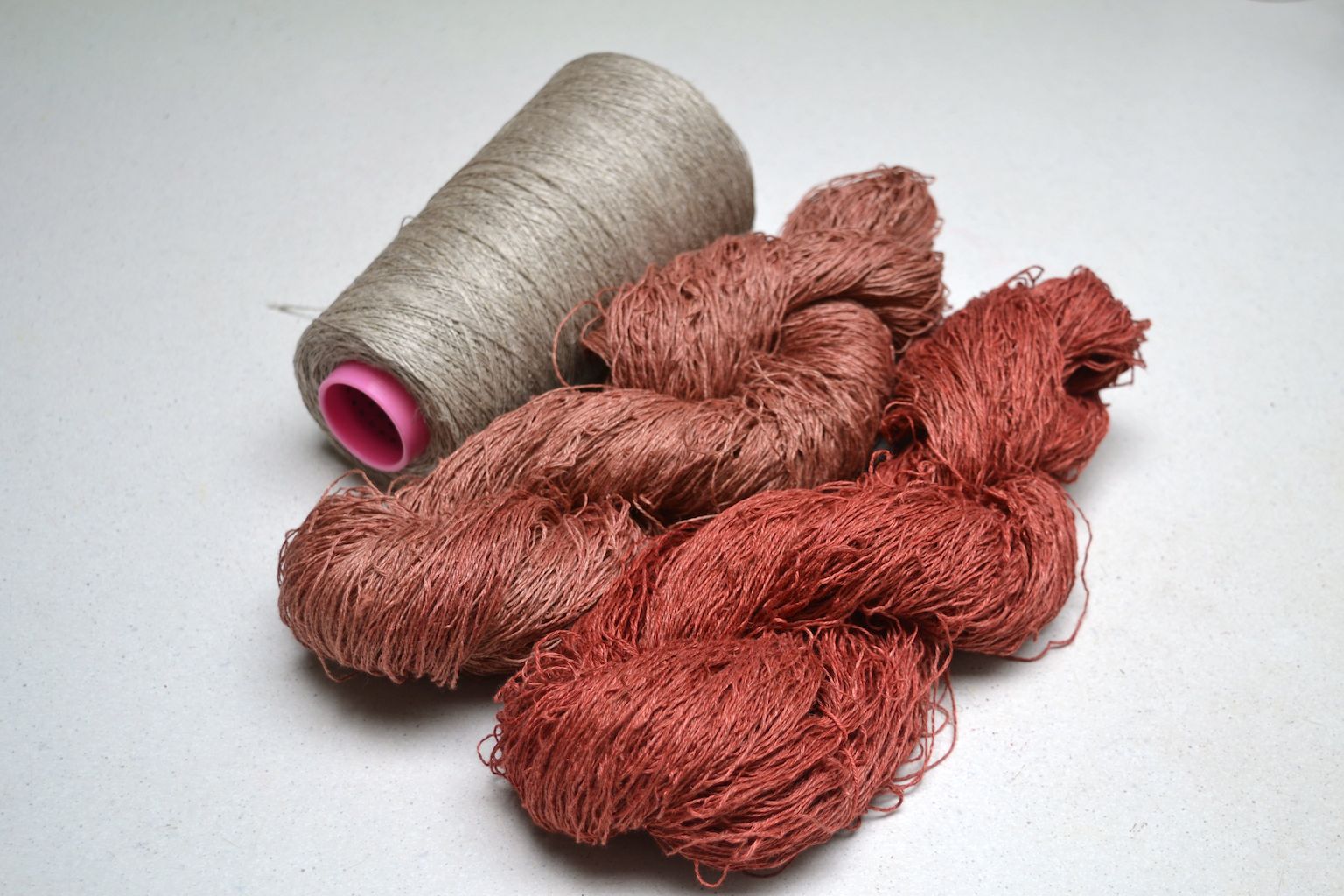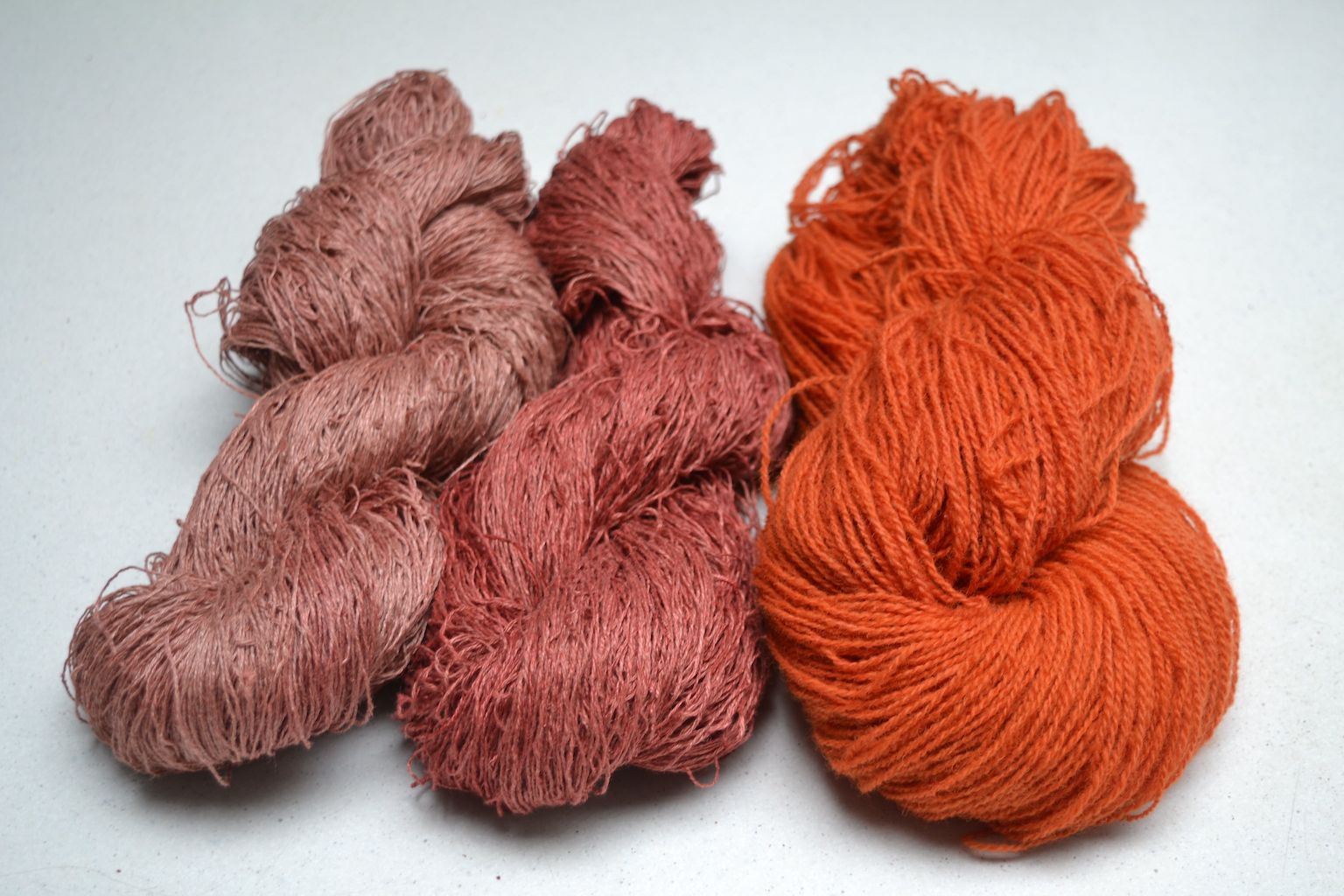Warm summer weather doesn’t exactly make you want to knit wool. So I’ve started dyeing Midsommer, a thin 3-ply pure linen yarn. So far, I’ve mostly dyed wool, and dyeing plant fibres really is something completely different.
Textiles made from linen are known way back in ancient times, and the oldest find of linen textile here in Denmark is from the Iron Age, about the year 200 (according to Den Store Danske). Later on, it looks like the Vikings loved wearing linen, and about 40% of found textiles from that time are made from linen.
Personally, I love linen, and I’ve worn the bottom out of main pairs of linen trousers. So why my focus on wool so far?
Begin scientific explanation:
Wool is made up of the protein keratin, just like other fibers from animals. Proteins are long chains of amino acids, and many of the amino acids in keratin have an electric charge.
When dyeing with natural dyes, the first step is mordanting. This is achieved by dissolving alum in water, adding the wool, and leaving it there for a shorter or longer time, typically with some heat applied.
Alum is a salt, so when you dissolve it in water, aluminum ions are released. They have a positive charge, and since opposites attract, the aluminum ions can bind to negative charges on keratin.
Afterwards, when the wool is transferred to the dye bath, the dye molecules bind to the aluminum ions that are attached to the wool. At that point, the dyer’s job is done: the dye is attached to the wool.
Plant fibers like cotton and linen are different. They do not consist of protein, but of cellulose. Cellulose is a long chain of sugar molecules, and they are not electrically charged. That means that aluminum ions will not bind to cellulose.
But tannins will bind to cellulose.
Tannins are a large and diverse group of molecules from plants. They have a few things in common: First, they can bind to proteins (this is what makes them useful for tanning). Secondly, they have a bitter, astringent taste (think cheap wine and unripe fruit). And thirdly, they are all polyphenols (that’s a matter of definition – don’t worry if you’re not sure what that means on a molecular level).
I’d like to recommend “The Science of Teaching with Natural Dyes” by Jeanne M. Buccigross to readers that are very interested in more details about wool and plant fiber structure and the chemistry of mordanting.
So tannin binds to cellulose, and now comes the clever bit: aluminum ions can bind to tannin. So with linen, the method is to bind tannin to cellulose, then bind aluminum ions to tannin, and finally bind dye molecules to aluminum ions.
End of scientific explanation.
In order to arrive at a practical method for naturally dying linen, I’ve been browsing through “The Art and Craft of Natural Dyeing” by J. N. Liles. I find his various methods a bit confusing, and everything is complicated by his use of different aluminum compounds. And most of all, he insists on using those hopeless units like ounces and pounds (grrrr).
But after re-calculating everything into SI units and removing several steps that looked superfluous to me, this is the method that I’m left with:
First, tannin treatment. I used pure tannic acid, but my next experiments will be on plant sources that are easily accessible.
For 100 g (3.53 ounces) of linen, I dissolved 5 g (0.18 ounces) of tannic acid in 70 C (158 F) warm water, so 5% WOF. I added the wet linen, made sure it was well mixed into the bath, then left it overnight without further heating.
After a good rinse to remove excess tannin, I mordanted the linen next day in 10% alum, exactly the same as with wool. Dyeing in 1:1 madder gave a beautiful, subtle red, and a weaker version of the same in the second bath:

The beautiful result is partially caused by dyeing on unbleached linen, so the greyish tone contributes to the final result. But there may be more going on than that. To see how much color was left in the bath, I dyed 100 g of wool. I had made the madder bath as 1:1 for my 100 g skein of linen, so 100 g of madder. Then I had dyed a second linen skein of 140 g. Normally, the madder bath would be rather exhausted, but look what happened to the wool:

The orange color on wool is really intense, and looks like an orange I’ve seen in 2nd baths of boiled or almost boiled madder. But I’m rather sure this bath wasn’t heated so much. The red on linen doesn’t seem to have any yellow component to it. It seems that the linen simply didn’t take up the yellow component of madder, leaving it for the wool? There’s clearly more experiments to be made here.
PS: Undyed Midsommer is available at my Etsy store, and later, naturally dyed versions will be available there, too.
